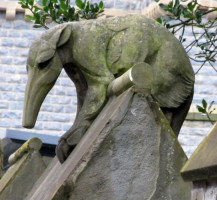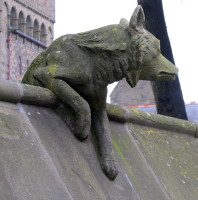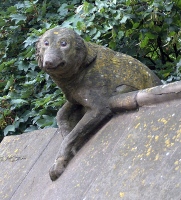 Sculpture of the Anteater.
Sculpture of the Anteater.
Cardiff’s Animal Wall is an example of a sculptural ensemble which is genuinely iconic of the city, appearing on numerous bits of official publicity, and of popular appeal, with small children keen to look at and name the different animals with their parents in tow.
The statues are to be found in Castle street, by Cardiff Castle. The are in a single long row, with two extra lions at the Castle end. Putting these two aside, which properly are associated with a side entrance to give it some weight, the Animal Wall sculptures are rather lively in composition, hanging over the wall rather than perched upon it. The sculptural treatment is playful rather than serious, a characteristic of the decorative work of William Burges, notable especially in his Pre-Raphaelite style cabinets, where the knights and maidens are at first sight stately and conventional, and then on a more careful examination revealed to be rather ironic. Most of the animals have glass beads inset for their eyes, absolutely not the done thing for sculpture since Classical times, and rather startling to behold. In alphabetical order:
This is the only anteater statue I am familiar with; it is of course a Giant Anteater, with its great heavy claws and lengthened nose, which has been replaced after damage; we cannot see the brush of the tail. The side view shows how it is seated completely over the balustrade, half in front, half behind; it is hard to imagine a Giant Anteater choosing to sit like this, but the skill of the composition and sculptor make it look natural. The treatment is far more spare in surface treatment than the other animals, excepting the ears and claws, and may reflect heavy restoration.
I think this is a Beaver, or at least some sort of giant rodent; conceivably a Capybara; I have not seen the tail to confirm one way or the other. Beaver statues are not usual, though there are several prominent ones on a building in Oxford Street, London.
A great shaggy animal, hanging over the wall and staring down at the spectator with lugubrious expression, the close-set marble eyes making it rather disconcerting.
Another extremely uncommon subject for animal sculpture. The line of bristles over the back is particularly good; the hunch of the back due to the posture over the top of the wall, and the positioning of the paws, are also made prominent features, as in the Bear.
Unusually, much more on the rear of the wall than the front, though the paws hang forward, and looking at its best extremely obliquely. Very catlike, the angle of the back legs being nicely captured, and the front legs of a massiveness that could not be a domestic beast.
Excellent up-pointed ears, twisted slightly forwards – this big cat has the most mobile of any feline’s ears – to give the statue of this beast a look of alertness, as if his interest has been captured by something in the distance.
A pair, the male seated upright, mouth open to show his fighting fangs, defending the female, who lies across his lap and nuzzles her face into his fur. A characteristic monkey pose.
The defining feature of this statue is the long, arched neck leading to the rather small head; as with the Lioness the solidity and power of the front legs are emphasised.
Yet another unusual subject in British sculpture of the period, though many earlier examples may be found in churches as the Pelican feeding her young. The treatment here is different, with the bird in repose, perched on top of the wall unlike most of the sculpture on the Animal Wall (the Vulture also does so) – with wings close to the body and their tips behind rather than in front of the balustrade. The long beak, lying against the curve of the breast for structural stability, gives the bird an almost heraldic look.
A pair, looking rather restored, with loss of most surface detail of the fur and musculature. The poses, though, are good, nicely capturing the curious, impatient nervousness of the living animal.
Almost the perfect sculpture for the Animal Wall, the flippers hanging down entirely naturally, the head up, alertly, giving a sleek profile, the tiny ears notable well back on the head (See this page for another Seal statue).
Another apparently restored statue, but as ever, with good pose, the strong taloned feet together, head twisted round to give the hooked-beak profile to the viewer. I am fairly sure this statue is a vulture rather than an eagle.

 The Wolf, after and before (right) restoration.
The Wolf, after and before (right) restoration.
I like this one, rather battered as it is, with the ears and mane replaced and some weathering of the body. Rather than a fierce wolf, we have a mild creature, the twist to the mouth and the setting of the glass eyes giving it a whimsical, almost sad expression.
These two, at one end of the Animal Wall, and as noted above, not really part of it, flank a side entrance to the Castle. Each is seated over the edge of the wall as with the other animals, and has glass eyes likewise. They are posed each supporting a heraldic shield with one paw on the top, and I think are rather bland compared to many of the lion statues found across Britain - for some examples, see this page.
Models of several of the animals may be seen in the Cardiff National Museum. The sculptor, Thomas Nicholls (c.1820-1895) is not particularly prominent, and according to information in the Museum, worked primarily on architectural sculpture for the architect, William Burges. Given that Burges was prone to carefully design all the decorative aspects of and within his buildings, this suggests that Nicholls was more of an artisan working up Burges’ designs than an imaginative artist producing his own creations.
Examples of several types of animal sculpture are gathered together in another portion of this site, accessed through the links on the Animal Sculpture page.
This page was originally part of a 'sculpture of the month' series, for January 2014. Although the older pages in that series have been absorbed within the site, if you would wish to follow the original monthly series, then jump to the next month (Feb 2014) or the previous month (Dec 2013). To continue, go to the bottom of each page where a paragraph like this one allows you to continue to follow the monthly links.
Also noted in Cardiff: sculpture on the Queen's Building // Glamorgan County Hall sculpture // Boer War Memorial
Sculpture in some towns in England // Sculptors
Visits to this page from 1 Jan 2014: 9,289